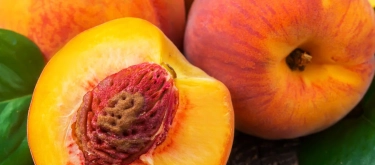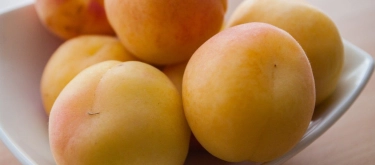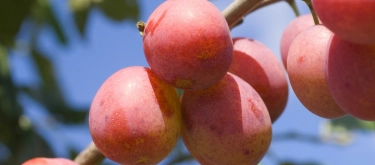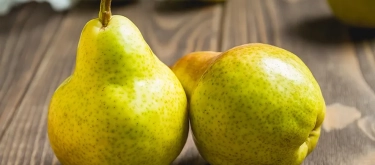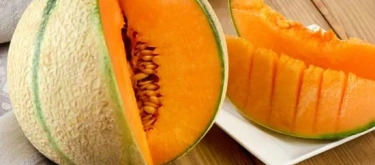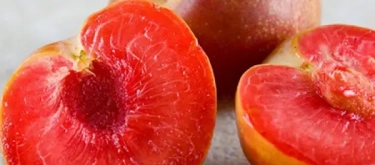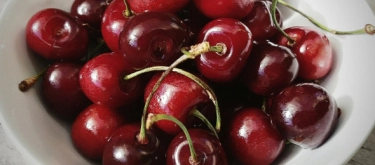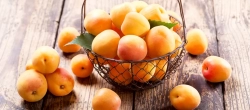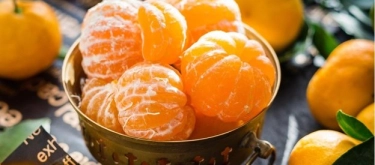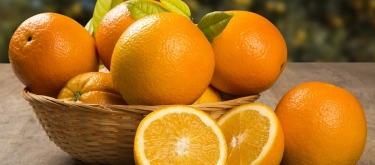Nectarine: Taste Profile, Aroma, Benefits and Health Risks
The nectarine (Prunus persica var. nucipersica) is a delicious, smooth-skinned variety of peach cherished for its sweet taste, succulent texture, and vibrant culinary versatility. Originating from China as a natural genetic variant of the peach, nectarines are extensively cultivated across temperate regions globally. Renowned for their juicy sweetness, appealing aroma, and delicate flesh, nectarines are commonly enjoyed fresh or featured prominently in desserts, salads, beverages, and savory culinary applications.
Nectarines are suitable for vegetarians, vegans, and gluten-free diets. They may trigger mild allergic reactions in individuals sensitive to stone fruits or birch pollen (Oral Allergy Syndrome). Additionally, their natural sugars require moderation for individuals managing blood sugar levels or diabetes.
What does Nectarine taste like?
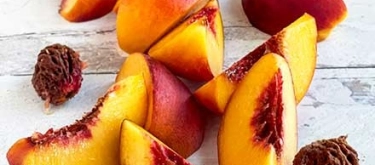
Complete Sensory Description
Taste
Nectarines offer a vibrant blend of sweetness and tangy acidity, featuring a distinctly juicy and refreshing profile. The sweetness is bright and pronounced, often richer and more intense than peaches, balanced perfectly by crisp, lively acidity. Flavor nuances range from mild, honeyed notes to complex tropical and berry undertones, sometimes accompanied by subtle floral or almond-like hints, especially close to the stone.
Aroma
Nectarines emit a fresh, appealing fragrance that blends sweet, fruity, and slightly floral aromatic notes. Predominantly influenced by volatile esters and lactones, their fragrance becomes richer and more enticing as they ripen. Nectarine’s aromatic bouquet, though generally milder than peaches, remains alluring, providing freshness and a pleasing sensory experience.
Texture
Nectarine flesh varies from firm and crisp to tender and meltingly juicy, depending on ripeness and variety. Typically denser and firmer than peaches, nectarines offer a satisfyingly crisp bite when less ripe, becoming softer, luscious, and exceptionally juicy at full maturity. The smooth, fuzz-free skin is thin and delicate, enhancing the textural enjoyment without the fuzzy sensation associated with peaches.
Appearance
Nectarines showcase vibrant shades of reddish-orange, golden yellow, or deep red with smooth, shiny, fuzz-free skin. Their flesh ranges from pale yellow to deep amber or white, sometimes displaying attractive reddish streaks near the pit, adding visual appeal in culinary preparations.
In-depth Flavor Analysis
The appealing flavor of nectarines results from complex interactions of sugars, organic acids, and aromatic compounds. Their sweetness primarily comes from fructose and sucrose, intensifying notably upon ripening. Nectarines typically contain slightly higher acidity than peaches—primarily malic acid with minor citric acid—giving them a vibrant, refreshing tartness balancing natural sweetness.
Flavor complexity arises from various volatile aromatic compounds, including lactones, aldehydes, esters, and terpenes. Gamma-decalactone provides characteristic fruity, creamy, peach-like nuances, while esters (such as ethyl acetate and hexyl acetate) introduce fresh, fruity, and mildly tropical elements. Benzaldehyde contributes subtle almond-like, floral notes, often noticeable near the pit.
The smooth skin texture of nectarines (resulting from the recessive gene mutation affecting fuzziness) influences their sensory profile by minimizing bitterness and increasing perceived sweetness intensity. The absence of fuzz also makes nectarines particularly appealing to individuals sensitive to peach fuzz.
Flavor variability depends heavily on climate and ripeness. Warm, sunny climates enhance sugar development, increasing sweetness, while cooler climates emphasize acidity, resulting in balanced sweetness, vibrant freshness, and aromatic depth.
Varieties and Culinary Applications
Yellow-Fleshed Nectarines
- Bright, sweet-tart balance, juicy flesh ideal fresh, grilled, baked, or in desserts, jams, and sauces.
White-Fleshed Nectarines
- Sweeter, less acidic, with delicate floral aromas; perfect fresh, in gourmet desserts, fruit salads, or paired elegantly with cheeses.
Donut Nectarines (Flat Nectarines)
- Mildly sweet, tender texture, convenient snack-size shape; excellent for fresh eating, fruit salads, and gourmet culinary presentations.
Culinary Versatility
Nectarines excel in diverse preparations:
- Fresh consumption: Perfect snacks, salads, fruit platters, or accompaniments to cheeses.
- Desserts: Nectarine tarts, cakes, cobblers, pastries, sorbets, or ice creams.
- Preserves & Sauces: Ideal jams, compotes, chutneys, sauces for meats or savory dishes.
- Beverages: Juices, smoothies, cocktails, and flavored waters.
- Savory Dishes: Grilled, roasted, or sautéed nectarines paired with poultry, pork, seafood, or salads.
Selection and Storage
Selecting Quality Nectarines
- Choose fragrant nectarines with smooth, vibrant skin, free from bruises or blemishes. Flesh should yield slightly under gentle pressure.
- Avoid overly firm, dull-colored, wrinkled, or bruised fruits.
Storage Recommendations
- Ripen nectarines at room temperature. Once ripe, refrigerate (2–4°C / 35–39°F) to extend freshness for 4–6 days.
- Handle gently; nectarines bruise easily due to thin skin.
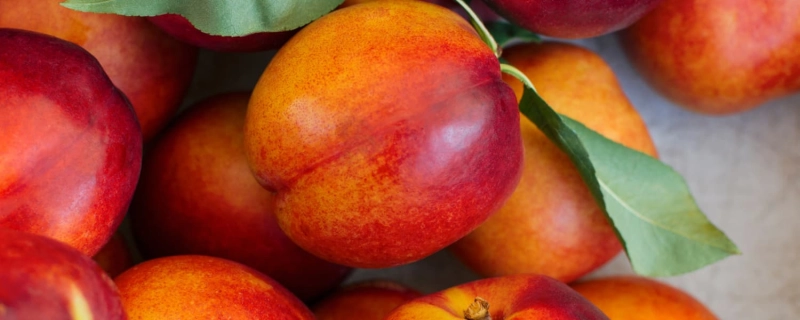
Nutritional Insights
-
Vitamin C & Antioxidants:
Excellent source of vitamin C and antioxidants (carotenoids, flavonoids) supporting immunity, cellular protection, and collagen production. -
Dietary Fiber:
Contains valuable dietary fiber, aiding digestion, gut health, cholesterol regulation, and weight management. -
Potassium & Minerals:
Moderate potassium content supports cardiovascular health, hydration, and electrolyte balance. -
Low-Calorie, Nutrient-Rich Fruit:
Nutrient-dense and low in calories, ideal for balanced, healthy diets and naturally sweet snacks.
Expert Insights & Culinary Tips
-
Optimal Ripeness:
Nectarines ripen quickly at room temperature; monitor closely to ensure ideal texture, aroma, and flavor intensity. -
Flavor Pairings:
Complement nectarines with almonds, vanilla, cinnamon, ginger, basil, mint, citrus, cheeses (ricotta, goat cheese), prosciutto, poultry, seafood, and wines like Riesling or sparkling wines. -
Cooking Recommendations:
Grilling or roasting nectarines intensifies sweetness, caramelizes sugars, enhances flavor depth, and provides delicious culinary versatility.
Interesting and Curious Facts
- Nectarines, genetically identical to peaches aside from smooth skin, resulted from a natural genetic mutation thousands of years ago.
- Nectarine cultivation spread globally from China through the Silk Road trade, historically valued for sweetness, fragrance, and appealing smooth skin.
- California is the world’s leading nectarine producer, growing approximately 95% of nectarines consumed in the United States.
Harm and Dietary Considerations
-
Oral Allergy Syndrome:
Individuals allergic to birch pollen or related fruits may experience mild allergic reactions to fresh nectarines. -
Sugar Content:
Natural sugars require moderation for individuals with diabetes or blood sugar concerns.
Religious Dietary Considerations
Nectarines are universally permissible across major religious dietary traditions:
- Islam: Permissible (Halal).
- Judaism: Permissible (Kosher, Parve).
- Hinduism & Buddhism: Widely permissible, frequently consumed during rituals or ceremonies.
- Christianity & Other religions: No known dietary restrictions.
Final Thoughts & Sensory Journey
Nectarines captivate with vibrant sweetness, refreshing juiciness, and appealing smooth skin. Perfect fresh or in diverse culinary creations, nectarines enrich dining experiences, providing nutritious enjoyment and irresistible sensory pleasure.
Resources
- McGee, H. (2004). On Food and Cooking: The Science and Lore of the Kitchen. Scribner.
- USDA FoodData Central (2023). Nectarine: Nutritional Profile and Culinary Uses.
- Food and Agriculture Organization (FAO). (2021). Stone Fruits: Cultivation, Nutrition, and Culinary Uses.
